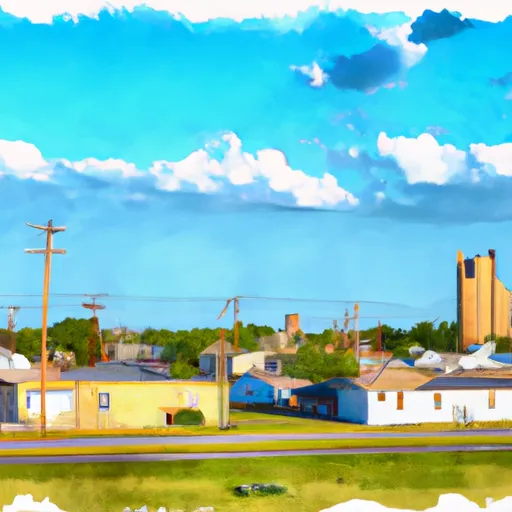-
 Snoflo Premium
Snoflo Premium
Get unlimited access to all our content
With no Ad interruptions! - Start Your Free Trial Login with existing account
Dennis
Eden Index
Climate
8.3
•
Recreation
3.7
•
Community
•
Safeguard
4.6/10

Dennis, Kansas is a small town located in the central part of the state with a population of just over 200 people. The climate in Dennis is characterized by hot summers and cold winters with an average annual temperature of 55 degrees Fahrenheit. The hydrology constituents in the area consist of small creeks and streams that flow into the nearby Medicine Lodge River. Outdoor recreation opportunities in Dennis include hunting and fishing in the surrounding areas, as well as hiking and camping in the nearby Cedar Bluff State Park. The park offers a variety of outdoor activities such as boating, swimming, and wildlife watching, making it a popular destination for visitors to the area.
What is the Eden Index?
The Snoflo Eden Index serves as a comprehensive rating system for regions, evaluating their desirability through a holistic assessment of climate health, outdoor recreation opportunities, and natural disaster risk, acknowledging the profound impact of these factors on livability and well-being.
Climate Health Indicator (CHI): 8.3
Dennis receives approximately
1075mm of rain per year,
with humidity levels near 84%
and air temperatures averaging around
14°C.
Dennis has a plant hardyness factor of
6, meaning
plants and agriculture in this region thrive during a short period during spring and early summer. Most
plants will die off during the colder winter months.
By considering the ideal temperature range, reliable water supplies, clean air, and stable seasonal rain or snowpacks, the Climate Health Indicator (CHI) underscores the significance of a healthy climate as the foundation for quality living.
A healthy climate is paramount for ensuring a high quality of life and livability in a region, fostering both physical well-being and environmental harmony. This can be characterized by ideal temperatures, reliable access to water supplies, clean air, and consistent seasonal rain or snowpacks.
Weather Forecast
Streamflow Conditions
Verdigris
Area Rivers
Verdigris
Snowpack Depths
Verdigris
Reservoir Storage Capacity
Verdigris
Groundwater Levels
Recreational Opportunity Index (ROI): 3.7
The Recreational Opportunity Index (ROI) recognizes the value of outdoor recreational options, such as parks, hiking trails, camping sites, and fishing spots, while acknowledging that climate plays a pivotal role in ensuring the comfort and consistency of these experiences.
Access to outdoor recreational opportunities, encompassing activities such as parks, hiking, camping, and fishing, is crucial for overall well-being, and the climate plays a pivotal role in enabling and enhancing these experiences, ensuring that individuals can engage in nature-based activities comfortably and consistently.
Camping Areas
| Campground | Campsites | Reservations | Toilets | Showers | Elevation |
|---|---|---|---|---|---|
| Porum Landing - Eufaula Lake | None | 597 ft | |||
| Brooken Cove - Eufaula Lake | None | 612 ft | |||
| Spaniard Creek - Webbers Falls Lake | None | 506 ft | |||
| Wahoo Bay - Fort Gibson Lake | None | 564 ft | |||
| Blackhawk RV Military - Camp Gruber | None | 590 ft | |||
| Belle Starr Park - Eufaula Lake | None | 614 ft | |||
| Dam Site South - Eufaula Lake | None | 652 ft | |||
| Deep Fork - Lake Eufaula State Park | None | 629 ft | |||
| Oak Ridge - Eufaula Lake | None | 597 ft | |||
| Highway 9 Landing - Eufaula Lake | None | 618 ft |
Catastrophe Safeguard Index (CSI):
The Catastrophe Safeguard Index (CSI) recognizes that natural disaster risk, encompassing floods, fires, hurricanes, and tornadoes, can drastically affect safety and the overall appeal of an area.
The level of natural disaster risk in a region significantly affects safety and the overall livability, with climate change amplifying these risks by potentially increasing the frequency and intensity of events like floods, fires, hurricanes, and tornadoes, thereby posing substantial challenges to community resilience and well-being.
Community Resilience Indicator (CRI):
The Community Resilience Indicator (CRI) recognizes that education, healthcare, and socioeconomics are crucial to the well-being of a region. The CRI acknowledges the profound impact of these elements on residents' overall quality of life. By evaluating educational resources, healthcare accessibility, and economic inclusivity, the index captures the essential aspects that contribute to a thriving community, fostering resident satisfaction, equity, and social cohesion.

